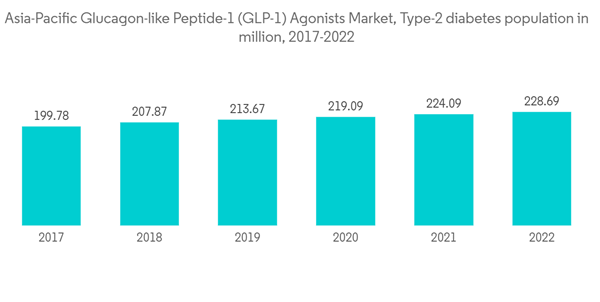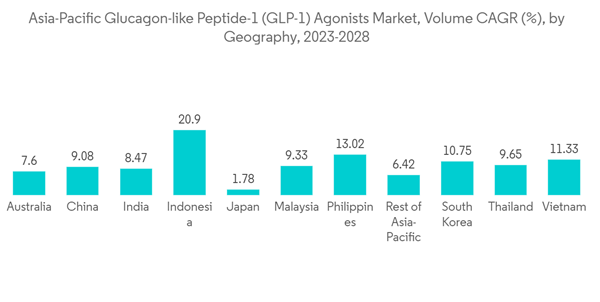The COVID-19 pandemic positively impacted the Asia-Pacific Glucagon-like Peptide-1 (GLP-1) Agonists Market. Diabetes and uncontrolled hyperglycemia are risk factors for poor outcomes in patients with COVID-19 including an increased risk of severe illness or death. People with diabetes have a weaker immune system, the COVID-19 complication aggravates the condition, and the immune system gets weaker very fast. People with diabetes have more chances to get into serious complications rather than normal people.
Glucagon-like peptide-1 receptor agonists (GLP-1RAs) are a class of medications used for the treatment of type 2 diabetes and some drugs are also approved for obesity. One of the benefits of this class of drugs over sulfonylureas or meglitinides is that they have a lower risk of causing hypoglycemia. Besides being important glucose-lowering agents, GLP-1RAs have significant anti-inflammatory and pulmonary protective effects and an advantageous impact on gut microbes' composition. Therefore, GLP-1RAs have been potential candidates for treating patients affected by COVID-19 infection, with or even without type 2 diabetes, as well as excellent antidiabetic (glucose-lowering) agents during COVID-19 pandemic times.
According to International Diabetes Federation (IDF), 90 million adults (20-79) are living with diabetes in the IDF South-East Asia (SEA) Region in 2021. This figure is estimated to increase to 152 million by 2045 and 206 million adults (20-79) are living with diabetes in the IDF Western Pacific Region in 2021 which is estimated to increase to 260 million by 2045. Diabetes mellitus has been of wide concern with its high prevalence, resulting in increased financial burdens for clinical systems, individuals, and governments. The market players are adopting various strategies such as collaborations, partnerships, mergers, acquisitions, and expansions to increase market share. Technological advancements have increased over the period leading to several modifications either in the Glucagon-like peptide-1 receptor agonists drugs or the formulations being developed.
Therefore, due to increased prevalence and the aforementioned factors, the studied market is anticipated to witness growth over the analysis period.
Asia-Pacific Glucagon-like Peptide-1 (GLP-1) Agonists Market Trends
Liraglutide Segment holds the highest market share in the Asia-Pacific Glucagon-like Peptide-1 (GLP-1) Agonists Market in the current year
The liraglutide segment holds the highest market share in the Asia-Pacific glucagon-like peptide-1 (GLP-1) agonists market and is expected to register a CAGR of about 4.9% over the forecast period.GLP1RAs have been available internationally and are recommended for use when escalation of treatment for type-2 diabetes is required after metformin and lifestyle management. They can be safely used with all other glucose-lowering therapies except vildagliptin. Liraglutide, sold under the brand name Victoza, is an anti-diabetic medication used to treat type-2 diabetes, obesity, and chronic weight management.
Liraglutide is used to control high blood sugar levels, either alone or in combination with other medications. It is prescribed to people who have type-2 diabetes. Liraglutide is also used to reduce the risk of a heart attack, stroke, or death in people with type-2 diabetes and heart disease. It works by increasing insulin release in response to high blood sugar levels after a meal and decreasing the amount of sugar produced by the liver. GLP1RAs elicit greater weight reduction and are recommended over SLGT2 inhibitors when cerebrovascular disease other than heart failure or renal disease predominates.
The Asia-Pacific region has witnessed an alarming increase in the prevalence of diabetes in recent years. In developing countries such as China and India, the rate of diabetes is at an all-time high. Diabetes is associated with many health complications. Patients with diabetes require many corrections throughout the day for maintaining normal blood glucose levels, such as anti-diabetic medication or the ingestion of additional carbohydrates, by monitoring their blood glucose levels. The rapidly increasing incidence and prevalence of diabetes and healthcare expenditure are indications of the increasing usage of diabetic drugs. The use of anti-diabetes drugs is rising because new-generation drugs reduce the rate of CV risk in diabetes patients.
China holds the highest market share in the Asia-Pacific Glucagon-like Peptide-1 (GLP-1) Agonists Market in the current year
China holds the highest market share in the Asia-Pacific glucagon-like peptide-1 (GLP-1) agonists market in the current year and is expected to register a CAGR of about 7.5% over the forecast period.As per the IDF 2021 report, an estimated 141 million adults were living with diabetes in China. The country had the highest number of deaths from diabetes in the Western Pacific region, at approximately 1.4 million, and the second-highest diabetes-related health expenditure in the world, at 165.3 billion USD. More than half of adults currently living with diabetes in China are undiagnosed. About 90% of people with diabetes have type-2 diabetes. The rise in the number of people with type-2 diabetes is driven by a complex interplay of socio-economic, demographic, environmental, and genetic factors. Key contributors include urbanization, an aging population, decreasing levels of physical activity, and increased levels of overweight and obesity.
Evidence suggests that type-2 diabetes can often be prevented, while early diagnosis and access to appropriate care for all types of diabetes can avoid or delay complications in people living with the condition. When diabetes is undetected or inadequately treated, people with diabetes are at risk of serious and life-threatening complications, such as heart attack, stroke, kidney failure, blindness, and lower-limb amputation. These result in reduced quality of life and higher healthcare costs. China has significantly improved the detection and management of diabetes with its pilot projects in NDAs (National Demonstration Areas) and its attempts to improve health system integration. These initiatives demonstrate a willingness to confront the rise of diabetes with strategies based on health promotion, disease detection, and management of the multiple conditions and complications associated with the disease.
Therefore, owing to the aforesaid factors, the growth of the studied market is anticipated in the Asia-Pacific region.
Asia-Pacific Glucagon-like Peptide-1 (GLP-1) Agonists Industry Overview
The Asia-Pacific glucagon-like peptide-1 (GLP-1) agonists market is consolidated with key manufacturers namely Eli Lilly, Sanofi, Novo Nordisk, and AstraZeneca etc. holding a presence in the region.Additional Benefits:
- The market estimate (ME) sheet in Excel format
- 3 months of analyst support
This product will be delivered within 2 business days.
Table of Contents
Companies Mentioned (Partial List)
A selection of companies mentioned in this report includes, but is not limited to:
- Novo Nordisk
- AstraZeneca
- Eli Lilly and Company
- Sanofi
- Biocon
- Novartis
Methodology

LOADING...










